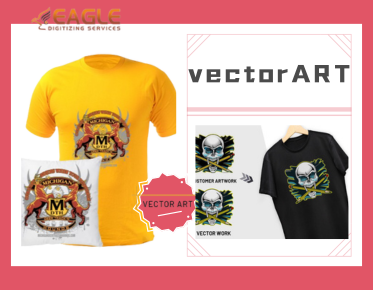Profitable Paths: Making Money as an Experienced Embroidery Digitizer
Embroidery digitizing isn't just about converting images into stitch files; it's a fusion of art and technology that breathes life into fabric. For those with a keen eye for design and a knack for precision, turning this craft into a thriving business presents a world of opportunities. Let's explore how mastering embroidery digitizing can open doors to entrepreneurial success.
Why Embroidery Digitizing is a Growing Market
The Rise of Personalized Products
In an era where personalization reigns supreme, consumers crave unique, custom-made items. Embroidery digitizing allows for exquisite customization, from monogrammed towels to bespoke corporate gifts, making it a sought-after service.
The Role of Custom Embroidery in Branding
Brands are continuously looking for methods to make themselves stand out. Custom embroidery on uniforms, promotional items, and merchandise enhances brand identity and fosters a professional image, boosting demand in the business sector.
Market Trends and Consumer Preferences
The trend towards DIY culture and handcrafted goods has seen a resurgence. Consumers are leaning towards products that reflect personal touch and craftsmanship, making embroidery digitizing a flourishing market niche.
Understanding the Skills Required for Embroidery Digitizing
The Artistic Eye: Design and Creativity
An embroidery digitizer must possess a vivid imagination and artistic flair. This role requires the ability to transform concepts into detailed, stitch-ready designs, balancing aesthetics with functionality.
Technical Proficiency: Software and Tools
Mastering embroidery digitizing software like Wilcom, Brother PE-Design, or Hatch is crucial. These tools require a blend of technical know-how and creativity to produce precise and intricate designs.
Attention to Detail: Precision and Accuracy
Embroidery digitizing demands meticulous attention to detail. Each stitch must be accurately placed to ensure the final product is flawless, making precision an indispensable skill.
Setting Up Your Embroidery Digitizing Business
Choosing the Right Equipment and Software
Investing in high-quality embroidery machines and reliable software is fundamental. These tools are the backbone of your business, influencing both the quality of your work and your productivity.
Creating a Productive Workspace
A well-organized, comfortable workspace enhances efficiency. Ensure you have ample lighting, a sturdy worktable, and storage solutions for your materials and tools.
Essential Business Licenses and Permits
Before launching, secure the necessary business licenses and permits. Compliance with local regulations not only legitimizes your business but also helps avoid legal pitfalls.
Building a Strong Portfolio
Showcasing a Variety of Styles and Techniques
A diverse portfolio demonstrates your versatility. Include samples that highlight different styles, from delicate floral patterns to bold, geometric designs.
Highlighting High-Quality Projects
Quality is your best marketing tool. Feature projects that showcase your best work, paying special attention to those with complex designs or intricate details.
Using Before and After Comparisons
Before-and-after images can be powerful. They highlight your ability to transform simple designs into elaborate embroidery, emphasizing your skill and expertise.
Identifying Your Target Market
Small Businesses and Corporate Clients
Small businesses and corporations often require custom embroidery for uniforms, promotional items, and gifts. This segment can be a lucrative and steady source of income.
Sports Teams and Organizations
Sports teams, clubs, and organizations frequently need embroidered apparel and gear, offering another significant market.
Individual Consumers and Hobbyists
Don’t overlook individual consumers. Personalized gifts, home decor, and fashion items cater to a broad audience, including hobbyists who appreciate unique, customized products.
Developing a Unique Selling Proposition (USP)
Emphasizing Quality and Precision
Your USP should highlight the superior quality and precision of your work. Consumers are willing to pay a premium for expertly crafted products.
Offering Customization and Personalization Options
Customization is key. Offering a wide range of personalization options can set your business apart and attract a diverse clientele.
Providing Fast Turnaround Times
In today's fast-paced world, speed matters. Offering quick turnaround times without compromising on quality can give you a competitive edge.
Pricing Your Services
Conducting Market Research
Research is essential to understand the going rates for similar services. This knowledge helps in setting competitive yet profitable prices.
Understanding Cost Structures
Factor in the costs of materials, equipment, and time. A clear understanding of your cost structure ensures your pricing covers expenses while yielding a profit.
Developing Competitive Pricing Strategies
Develop strategies that reflect the value you offer. Consider tiered pricing based on the complexity and customization level of the designs.
Marketing Your Embroidery Digitizing Business
Creating an Eye-Catching Website
A professional website serves as your digital storefront. Ensure that it is visually beautiful, easy to navigate, and effectively displays your portfolio.
Utilizing Social Media Platforms
Social media is a powerful marketing tool. Platforms like Instagram, Facebook, and Pinterest allow you to share your work, connect with potential clients, and build your brand.
Networking at Industry Events and Trade Shows
Industry events and trade shows offer networking opportunities. They enable you to meet potential clients, learn about market trends, and stay updated with industry developments.
Building Relationships with Clients
Offering Exceptional Customer Service
Exceptional customer service fosters loyalty. Ensure your clients feel valued and heard, and go the extra mile to meet their needs.
Developing Long-Term Partnerships
Long-term partnerships can provide steady business. Build trust with your clients by consistently delivering high-quality work and maintaining open communication.
Asking for Referrals and Testimonials
Referrals and testimonials are invaluable. Satisfied clients can provide powerful word-of-mouth marketing, helping you attract new business.
Leveraging Online Marketplaces
Selling on Etsy and Other Craft Platforms
Etsy and similar platforms offer a global marketplace for your products. These sites can help you reach a wider audience and generate additional income.
Utilizing Freelance Sites for Additional Income
Freelance sites like Upwork and Fiverr can provide additional revenue streams. These platforms connect you with clients looking for custom embroidery digitizing services.
Building an Online Storefront
Consider creating your own online store. This allows you to control your brand image and customer experience, driving direct sales and increasing profits.
Expanding Your Service Offerings
Providing Embroidery Supplies and Kits
Offering supplies and kits can diversify your income. These products appeal to DIY enthusiasts and hobbyists, expanding your customer base.
Offering Training and Workshops
Sharing your expertise through training and workshops can establish you as an authority in the field. These events can also generate additional revenue.
Collaborating with Local Craft Stores
Partnerships with local craft stores can be mutually beneficial. They can help you reach new customers and provide a venue for your products and workshops.
Managing Your Business Finances
Setting Up a Business Bank Account
A separate business bank account simplifies financial management. It helps in tracking expenses, managing income, and preparing for tax season.
Keeping Accurate Records and Invoicing
Accurate record-keeping is essential for financial health. Use reliable accounting software to track your finances and ensure timely, accurate invoicing.
Understanding Taxes and Deductions
Understanding tax obligations and available deductions can save you money. Consider consulting with a tax professional to navigate the complexities of business taxes.
Ensuring High-Quality Output
Conducting Regular Equipment Maintenance
Regular maintenance of your equipment ensures consistent quality and prevents costly breakdowns. Keep a maintenance schedule and follow manufacturer guidelines.
Implementing Quality Control Processes
Quality control processes catch errors before they reach the customer. Develop a checklist to ensure each project meets your high standards.
Staying Updated with Industry Standards
Stay abreast of industry standards and trends. This knowledge helps you maintain competitive quality and stay relevant in a dynamic market.
Navigating Common Challenges
Handling Difficult Clients
Difficult clients are a reality. Handle them with patience and professionalism, aiming to resolve issues amicably while protecting your interests.
Managing Production Deadlines
Efficient time management is crucial. Plan your projects carefully, set realistic deadlines, and communicate clearly with clients to manage expectations.
Staying Motivated and Avoiding Burnout
Running a business can be demanding. Prioritize self-care, set boundaries, and find a balance to stay motivated and avoid burnout.
Embracing Innovation and Technology
Exploring New Embroidery Techniques
Innovation keeps your work fresh and exciting. Experiment with new techniques to expand your skill set and offer unique designs.
Investing in Advanced Software
Advanced software can enhance your capabilities and improve efficiency. Stay updated with the latest tools to maintain a competitive edge.
Keeping Up with Industry Trends
Industry trends can provide inspiration and direction. Follow industry publications, attend events, and engage with the community to stay informed.
Sustainability in Embroidery Digitizing
Using Eco-Friendly Materials
Sustainability is increasingly important. Using eco-friendly materials can appeal to environmentally conscious consumers and differentiate your brand.
Reducing Waste and Optimizing Resources
Reducing waste and optimizing resources can improve profitability and sustainability. Implement practices that minimize waste and make the most of your materials.
Promoting Sustainable Practices to Clients
Educate your clients about sustainable practices. This not only promotes environmental responsibility but also aligns your brand with modern values.
Future Opportunities in Embroidery Digitizing
Exploring Niche Markets
Niche markets offer untapped potential. Explore areas like pet accessories, wedding decor, or tech accessories to find unique opportunities.
Adapting to Consumer Demands
Consumer preferences evolve. Stay attuned to their needs and adapt your offerings to meet emerging trends and demands.
Scaling Your Business for Growth
Scaling requires strategic planning. Consider expanding your team, investing in additional equipment, or exploring new markets to grow your business.
Embroidery digitizing offers endless possibilities for those willing to embrace the art and business of it. By honing your skills, understanding the market, and building strong client relationships, you can transform this craft into a thriving business. Whether you're just starting or looking to expand, the journey promises creativity, innovation, and success.



